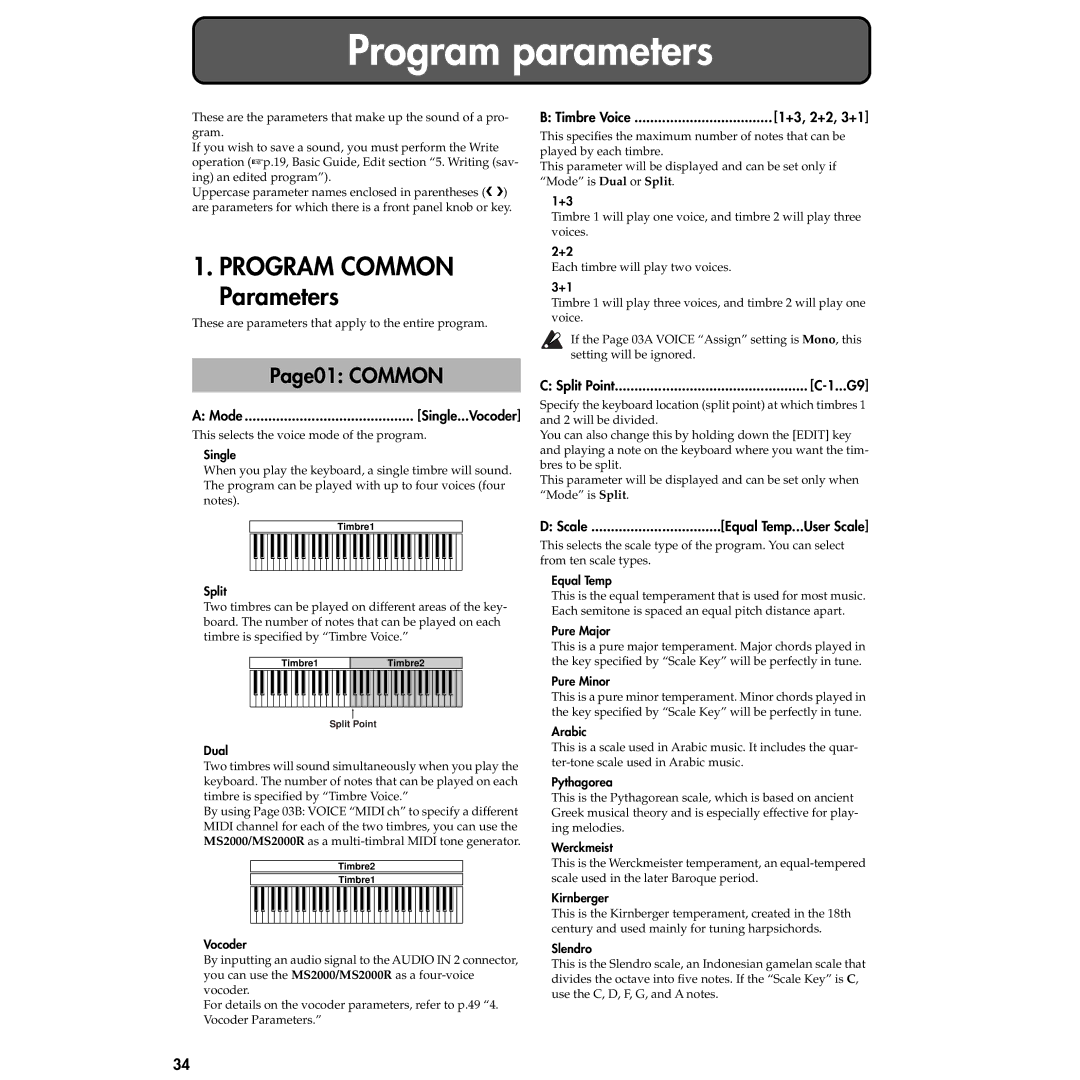
Program parameters
These are the parameters that make up the sound of a pro- gram.
If you wish to save a sound, you must perform the Write operation (☞p.19, Basic Guide, Edit section “5. Writing (sav- ing) an edited program”).
Uppercase parameter names enclosed in parentheses ( ) are parameters for which there is a front panel knob or key.
1. PROGRAM COMMON Parameters
These are parameters that apply to the entire program.
Page01: COMMON
A: Mode | [Single...Vocoder] |
This selects the voice mode of the program.
Single
When you play the keyboard, a single timbre will sound. The program can be played with up to four voices (four notes).
Timbre1
Split
Two timbres can be played on different areas of the key- board. The number of notes that can be played on each timbre is specified by “Timbre Voice.”
Timbre1 | Timbre2 |
|
|
Split Point
Dual
Two timbres will sound simultaneously when you play the keyboard. The number of notes that can be played on each timbre is specified by “Timbre Voice.”
By using Page 03B: VOICE “MIDI ch” to specify a different MIDI channel for each of the two timbres, you can use the MS2000/MS2000R as a
Timbre2
Timbre1
Vocoder
By inputting an audio signal to the AUDIO IN 2 connector, you can use the MS2000/MS2000R as a
For details on the vocoder parameters, refer to p.49 “4. Vocoder Parameters.”
B: Timbre Voice | [1+3, 2+2, 3+1] |
This specifies the maximum number of notes that can be played by each timbre.
This parameter will be displayed and can be set only if “Mode” is Dual or Split.
1+3
Timbre 1 will play one voice, and timbre 2 will play three voices.
2+2
Each timbre will play two voices.
3+1
Timbre 1 will play three voices, and timbre 2 will play one voice.
If the Page 03A VOICE “Assign” setting is Mono, this setting will be ignored.
C: Split Point |
Specify the keyboard location (split point) at which timbres 1 and 2 will be divided.
You can also change this by holding down the [EDIT] key and playing a note on the keyboard where you want the tim- bres to be split.
This parameter will be displayed and can be set only when “Mode” is Split.
D: Scale | [Equal Temp...User Scale] |
This selects the scale type of the program. You can select from ten scale types.
Equal Temp
This is the equal temperament that is used for most music. Each semitone is spaced an equal pitch distance apart.
Pure Major
This is a pure major temperament. Major chords played in the key specified by “Scale Key” will be perfectly in tune.
Pure Minor
This is a pure minor temperament. Minor chords played in the key specified by “Scale Key” will be perfectly in tune.
Arabic
This is a scale used in Arabic music. It includes the quar-
Pythagorea
This is the Pythagorean scale, which is based on ancient Greek musical theory and is especially effective for play- ing melodies.
Werckmeist
This is the Werckmeister temperament, an
Kirnberger
This is the Kirnberger temperament, created in the 18th century and used mainly for tuning harpsichords.
Slendro
This is the Slendro scale, an Indonesian gamelan scale that divides the octave into five notes. If the “Scale Key” is C, use the C, D, F, G, and A notes.
34
